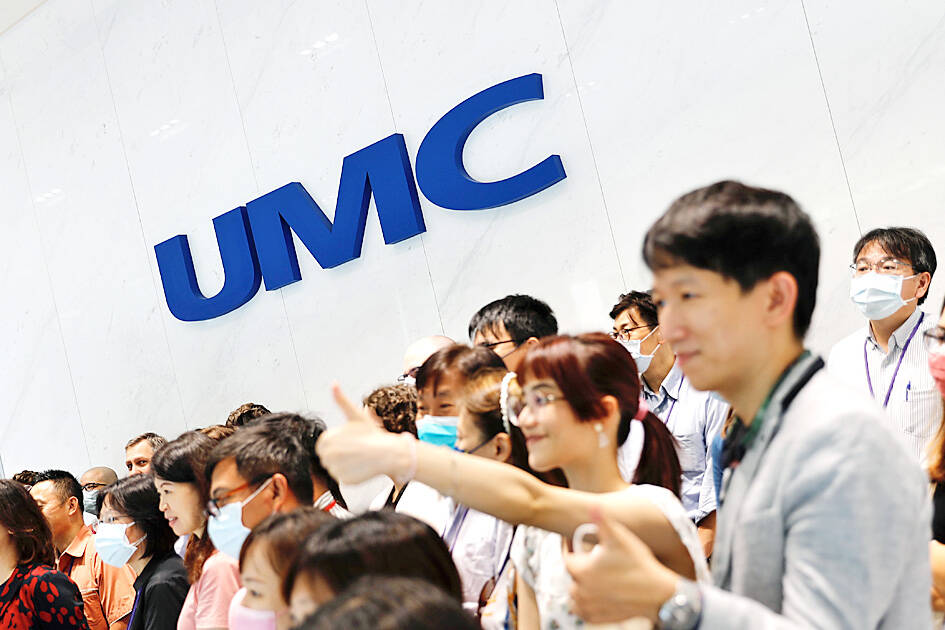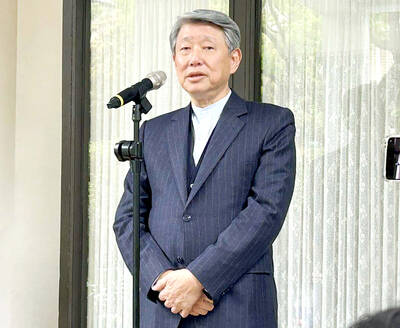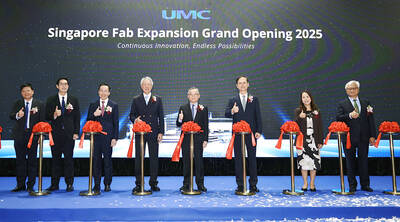United Microelectronics Corp (UMC, 聯電), the world’s No. 3 contract chipmaker, yesterday said its factory utilization would fall to the low 60 percent range this quarter as customers grapple with excess inventory, although early signs indicate that demand is stabilizing in the PC and smartphone segments.
UMC provided the business outlook after reporting a 1.4 percent sequential improvement in net profit last quarter to NT$15.97 billion (US$493.8 million), from NT$15.64 billion in the second quarter, while factory utilization stood at 67 percent, the lowest in about 12 years.
On an annual basis, net profit plunged about 41 percent from NT$26.99 billion, the company said.

Photo: Ritchie B. Tongo, EPA-EFE
“For the fourth quarter, with recent rush orders from PC and smartphone makers, we expect demand to gradually stabilize. However, customers are still maintaining a cautious and conservative approach in addressing inventory levels, while the conditions for the automotive business appears challenging,” UMC co-CEO Jason Wang (王石) told a virtual investors’ conference.
The automotive segment became the latest victim of an inventory correction cycle, Wang said, adding that UMC expects the inventory digestion to continue into next year.
That would lead to a decline in UMC’s auto chip business this quarter, but overall, auto chips would still make up about 15 percent of the company’s chip revenue this year, he said.
The PC and Chinese smartphone segments would remain stable compared with last quarter, he added.
Customers’ inventory digestion and stagnant end-product demand are expected to reduce UMC’s wafer shipments by 5 percent sequentially this quarter, the chipmaker said.
Average selling prices would be flat quarter-on-quarter, but with intensifying competition from Chinese rivals, the chipmaker said it might adjust prices downward for 8-inch wafers.
Gross margin is to fall to the low-30 percent range this quarter, from 35.9 percent last quarter, the company said.
However, UMC retained its capital expenditure for this year at US$3 billion and kept intact its Tainan’s P6 fab capacity expansion plan with 22-nanometer and 28-nanometer chip capacity designated for customers signing long-term supply agreements.
The chipmaker expects the P6 fab’s capacity to climb to 12,000 wafers per month by the end of this year and to rise further to 315,000 wafers per month by September next year.
In Singapore, a new clean room for its P3 fab is to be ready by the first half of next year as scheduled, the company said.
Last quarter, 22-nanometer and 28-nanometer chips together accounted for 32 percent of its total revenue, up from 29 percent in the second quarter.
To further differentiate its offerings, UMC is considering converting some of its 22-nanometer or 28-nanometer capacity into 12-nanometer fin field-effect transistor technology in response to customers’ demand for power-efficient chips, it said.
The firm also kept its artificial-intelligence (AI) packaging capacity expansion plans unchanged. It is to double its silicon interposer wafer capacity to 6,000 units by the first quarter of next year.
In addition to AI chip packaging capacity, UMC expects strong demand for related microcontroller units and chips with functionality such as sensing and connectivity, which is within its addressable market, it said.
“UMC is preparing those solutions for this market. That includes interposer solutions as well. We hope that with those solutions prepared we can enable our customers to capture market share in the AI application field. Many products we engage with today show there is a high possibility customers will start adding AI functions into end devices,” Wang said.

MULTIFACETED: A task force has analyzed possible scenarios and created responses to assist domestic industries in dealing with US tariffs, the economics minister said The Executive Yuan is tomorrow to announce countermeasures to US President Donald Trump’s planned reciprocal tariffs, although the details of the plan would not be made public until Monday next week, Minister of Economic Affairs J.W. Kuo (郭智輝) said yesterday. The Cabinet established an economic and trade task force in November last year to deal with US trade and tariff related issues, Kuo told reporters outside the legislature in Taipei. The task force has been analyzing and evaluating all kinds of scenarios to identify suitable responses and determine how best to assist domestic industries in managing the effects of Trump’s tariffs, he

TIGHT-LIPPED: UMC said it had no merger plans at the moment, after Nikkei Asia reported that the firm and GlobalFoundries were considering restarting merger talks United Microelectronics Corp (UMC, 聯電), the world’s No. 4 contract chipmaker, yesterday launched a new US$5 billion 12-inch chip factory in Singapore as part of its latest effort to diversify its manufacturing footprint amid growing geopolitical risks. The new factory, adjacent to UMC’s existing Singapore fab in the Pasir Res Wafer Fab Park, is scheduled to enter volume production next year, utilizing mature 22-nanometer and 28-nanometer process technologies, UMC said in a statement. The company plans to invest US$5 billion during the first phase of the new fab, which would have an installed capacity of 30,000 12-inch wafers per month, it said. The

Taiwan’s official purchasing managers’ index (PMI) last month rose 0.2 percentage points to 54.2, in a second consecutive month of expansion, thanks to front-loading demand intended to avoid potential US tariff hikes, the Chung-Hua Institution for Economic Research (CIER, 中華經濟研究院) said yesterday. While short-term demand appeared robust, uncertainties rose due to US President Donald Trump’s unpredictable trade policy, CIER president Lien Hsien-ming (連賢明) told a news conference in Taipei. Taiwan’s economy this year would be characterized by high-level fluctuations and the volatility would be wilder than most expect, Lien said Demand for electronics, particularly semiconductors, continues to benefit from US technology giants’ effort

‘SWASTICAR’: Tesla CEO Elon Musk’s close association with Donald Trump has prompted opponents to brand him a ‘Nazi’ and resulted in a dramatic drop in sales Demonstrators descended on Tesla Inc dealerships across the US, and in Europe and Canada on Saturday to protest company chief Elon Musk, who has amassed extraordinary power as a top adviser to US President Donald Trump. Waving signs with messages such as “Musk is stealing our money” and “Reclaim our country,” the protests largely took place peacefully following fiery episodes of vandalism on Tesla vehicles, dealerships and other facilities in recent weeks that US officials have denounced as terrorism. Hundreds rallied on Saturday outside the Tesla dealership in Manhattan. Some blasted Musk, the world’s richest man, while others demanded the shuttering of his